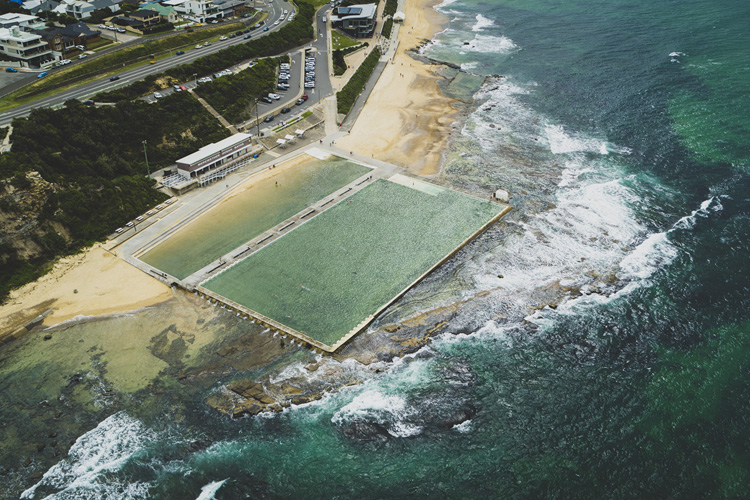Things I wish I’d done in Australia
Learn to surf

Image: Visit Victoria
Surfing wasn’t invented in Australia but few countries absorb it into mainstream culture quite like the Aussies. And it’s easy to see why, because this is a continent ringed by an almost unfair number of mind-blowing surf beaches. Heck, you could narrow your choices down to only beaches beginning with the letter “B” and you’d still get a short list most surfers would dream of: Bondi, Byron Bay, Bells Beach…
If you’re keen to ride a wave (or at least have a good time practicing your falling…) it’s easy to find someone willing to show you how it’s done. From surf schools and multi-day surf camps to private lessons or just hiring a board and having a go, surfing in Australia is accessible for all ages and skill levels. The best known beaches are well catered for, but even out-of-the way spots should have you covered – you might just need to ask around. Unless you’re dropping in on their wave, surfers are a pretty laid-back and friendly bunch, proud of their patch and only too happy to share some tips. And when it comes to surf conditions, a little local knowledge can go a long way.
Dive into an ocean pool

Image: Destination NSW
If surfing seems a bit strenuous – or if you’re just not cool with the idea of sharing a wave with a passing shark – another impressive salt water experience awaits just along the shoreline in the form of the great Aussie ocean pool.
These glistening gems are man-made pools, cut from rock or built partly from concrete, that give you the refreshing buzz of an ocean swim with the relative calm and safety of a traditional swimming pool. They genuinely are the best of both worlds. And they’re absolutely stunning to look at, with their straight lines and irregular shapes contrasting spectacularly against the natural contours of the coast.
Ocean pools are mainly found on the East Coast, with an especially high concentration in New South Wales where they have long served as egalitarian community hubs, but you will find them dotted around other states too. So whenever you’re near the coast, keep your eyes peeled and your togs handy because any time you spy an ocean pool, it’s time for a swim.
Go to a big match

Image: Destination NSW
Whether they're decked out in club colours to support a local side or packed into a green-and-gold clad pub to cheer on a national team, Aussies are absolutely mad for sports. It’s an enormous source of pride, unity, and cultural identity – plus they’re really good at it, so there’s usually plenty to celebrate.
For a true-blue Aussie sporting experience, it’s hard to beat the unique domestic professional leagues. Perhaps the best example is AFL, or “Aussie Rules” football. Played by almost no-one else in the world, in the state of Victoria this expansive and impressively athletic running-jumping-kicking game is a way of life that regularly sees 90,000 fans packing the stands to barrack for their team.
Likewise, Rugby League (NRL) is a minnow on the world stage but in its New South Wales and Queensland strongholds it’s a ferocious affair, full of long-simmering club rivalries that often threaten to boil over as two teams of extremely large humans, sans padding, take turns trying to bulldoze through each other to place an oval shaped ball at the other end of a field. It’s as simple and brutal as it is brilliant.
Unlike many countries, football (the round ball variety) in Australia sits slightly further down the sporting pecking order. However, at its best, the A-League rivals any other local sporting contest for atmosphere; get in the stands for a Sydney or Melbourne derby for a taste of the intensity. At the highest level, the national women’s football team, the Matildas, are the country’s undisputed sporting darlings and tickets to their matches are the hottest in town.
While the football codes fight it out during winter, the arrival of summer sees parochialism set aside for the national love of cricket. The Australian men’s and women’s cricket teams are perennially ranked at the top of the world and their matches are followed closely from coast to coast. As a sporting spectacle, a lot happens very slowly in cricket (test matches can take up to five days to get a result), making a live game a laid-back sporting experience and the perfect backdrop to those long, hot Aussie summers.
Go camping
The hardest thing about camping in Australia is choosing where to do it. Beach or bush? Alpine views or outback skies? Unfortunately, in a country with such an expansive range of natural beauty, these are the tough choices one must make. But once you’re over that hump you’ll be rewarded with an experience you’ll remember for the rest of your life. Seriously, there’s nothing that quite prepares you for the moment you open your tent to see a kangaroo bounding by.
The network of campgrounds across Australia is vast, accessible, affordable and, in general, facilities are kept to a good standard. Even the most basic free roadside camping spots tend to offer up at least a working toilet and a gas barbecue, providing some welcome relief on epic long drives.
As well as being a perfectly awesome experience it itself, camping tends to put you on the doorstep of further adventures, from hiking in national parks to cycling, kayaking, snorkelling, fishing, and more. So get yourself a tent, rent a van, or sleep under the stars if you have to. Just don’t forget the bug spray…
Stargaze

Image: Destination NSW
How do you make a country as big as Australia feel small? Just gaze up into the infinite vastness of the Southern Hemisphere night sky.
The innumerable constellations and astronomical wonders that can be observed in this part of the world are almost entirely hidden within the bright lights of the big cities. But when you’re free from the urban glow the sky opens, as if emerging from a tunnel, to reveal an astonishing display of celestial marvels.
Spending time beneath this sprawling, sparkling blanket in the stillness of the night can be an incredibly powerful, even spiritual, experience. There’s an indescribable connection you get from knowing that you’re looking upon the very same stars seen by countless generations before. These are the starting points of ancient Aboriginal myths and stories, the maps and markers for epic journeys, and an unending source of mystery and wonder.
A pro tip from experienced stargazers is to allow plenty of time for your eyes to adjust to the total darkness before the whole picture becomes clear. So turn off those torches, put that phone down, and stand in awe at the incomprehensible bigness of the universe.
Open your eyes to art

Image: Visit Victoria
Australia's art culture is a ridiculously rich tapestry that weaves together some of the most ancient art on the planet, old world expressionism, stunning studies of a truly unique environment, important contemporary commentary, and so much more. And the great news is that it’s almost everywhere you look, and most of it is free.
For a convenient starting point, the country's public museums and galleries play a pivotal role as custodians of a wide-reaching collection that spans centuries. The biggest of these institutions, such as the National Gallery of Australia (Canberra), the Art Gallery of New South Wales (Sydney), and the National Gallery of Victoria (Melbourne) are more than worth your time for a cultural primer. In those same cities, the urban art scene feels dynamic and alive, with once-maligned graffiti and murals now helping transform laneways and alleys into open-air galleries that showcase the prodigious talent of local artists. Combined with sculptures and installations that range from weird and wonderful to completely confronting, art in the city can be a fully immersive experience.
But for something truly special, it’s essential to explore the profound and enduring contribution of Indigenous art, which serves as a cornerstone of Australia's cultural identity. With a deep, deep connection to the land and Dreamtime stories providing a thread that has spanned countless generations, the Indigenous art here is a rare portal into the heritage of a truly ancient culture.
Eat local
Discovering the unique delights of local cuisine can be one of the enduring highlights of any overseas trip, And it’s safe to say Australia offers opportunities to eat things you won’t get to try anywhere else in the world.
Fancy a kangaroo sausage? What about an emu burger? Or perhaps a crocodile curry? Yes, these iconic creatures that have pride of place on Australia’s coat of arms also feature on menus across the country. What’s more, they’re actually considered to be pretty healthy and sustainable as far as meat goes. (It’s probably important to mention you can’t just go out and kill a kangaroo or crocodile for your dinner; most wildlife is legally protected and all hunting and farming is strictly regulated, so don’t even think about it!)
If meat isn’t part of your diet, there’s a long list of native fruits, herbs, and spices to tickle your palate. From bush tomatoes and Kakadu plums to finger limes and Bunya nuts, there are plenty of simple ways to add some local flavour to your cooking.
And then there’s Vegemite...This pitch-black yeast spread has been produced for over a hundred years and is an undisputed icon of Australian culture. With a flavour that sits somewhere between savoury and salty with a touch of umami, it’s a firm love-it-or-hate-it thing. There is no in between. Given the country’s open attitude towards food innovation, Vegemite now courses through Aussie cuisine in all kinds of inventive ways, but if you’re trying it for the first time, do as the locals do and spread it on toast. Just use it sparingly because a little bit of Vegemite goes a long way!
Enjoy some small town charm
There’s no denying that Australia’s major cities have a lot going for them, but any trip Down Under is made far more culturally rich and rewarding if you take time to check out the smaller towns in between.
The first thing you’ll notice is the pace tends to be slower, and that brings benefits. With fewer crowds to contend with, the hospitality tends to be warmer, the chats longer, and the recommendations more valuable; if anyone knows about hidden gems, from places to eat to local specialities, it’s the people that live there.
From the lush green hills of Berry to the mineral springs of Daylesford, the tropical paradise of Port Douglas or the old world European charm of Hahndorf, there’s a staggeringly wide range of small town charms to experience across this incredibly diverse land. And of course many small towns act as gateways to other spectacular sights and natural wonders.
Likewise, smaller towns often have outsized historical significance. Whether it's a gold rush town, an historic port, or an Indigenous cultural site, these are the kinds of places that can offer an important window into the nation's past. So when you’re travelling around the country, don’t just blow through. Take some time to take in the lesser-known places that help make Australia the cultural melting pot it is.
Book ahead
There’s no getting around the fact that Australia is a hugely popular global tourist destination and affordable accommodation can fill up quickly. So when it comes to finding a place to stay, the best way to get more bang for your Aussie bucks is to book as far ahead as you possibly can.
Sure, that’s easier said than done when you don’t always know where you want to go – let alone when you want to be there – but even if you can build an itinerary around a few key places and dates, it can save you a whoooole lot of money and hassle in the long run. Alternatively, it’s a good idea to look for flexible booking options and places with free change and cancellation policies *cough* YHA *cough* so you can tweak your plans without being stung in the pocket.
As part of your planning it’s also worth taking a quick look at state and national public holidays, as well as school holidays, and do your best to avoid having to compete with travelling locals for rooms at super busy times. Ditto for major events like concerts and sporting fixtures.
And one final tip: sometimes paying a little more for accommodation that’s closer to the action can actually save money (and time) you’d otherwise just spend on transport.
Stay a bit longer
In case you hadn’t gotten the picture yet, Australia is really big. Seriously, go look at a map – it’s massive. You could live there for years and struggle to see all the highlights. But, of course, the longer you stay, the more opportunities you have to get out and see stuff. So while you’re there, why not stay longer?
Australia has a number of working visa options that allow travellers to move around the country, find work, and earn a bit of cash to extend their holiday. If you feel like you’ll need more time to tick things off your Aussie bucket list, this can be an excellent way to do it. Whether you’re looking for something temporary or seasonal (or even permanent), applying for a working visa is a well-worn path for extending your stay in Australia; you’ll find farms and fields across the country flush with backpackers doing what they need to do to make their Aussie adventure last a little (or a lot) longer.
If that sounds like you, the Australian Government’s Department of Home Affairs website has all the info you need to know.
Words: Nick Oscilowski
Share your stay
Tag us in your social posts and share your story by using #yhaoz or #yhaaustralia


